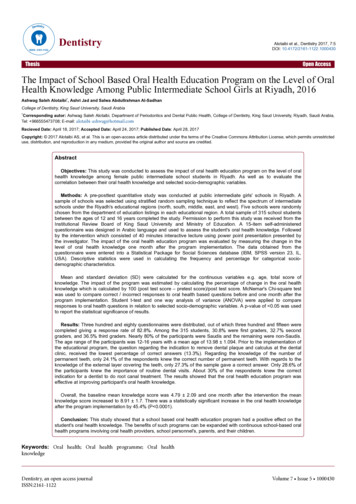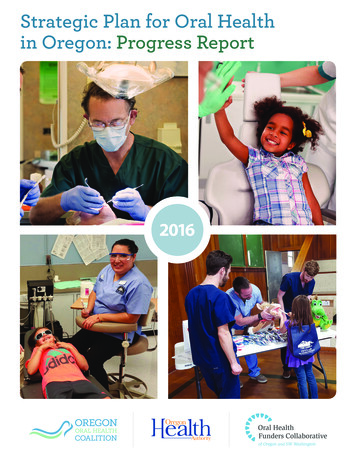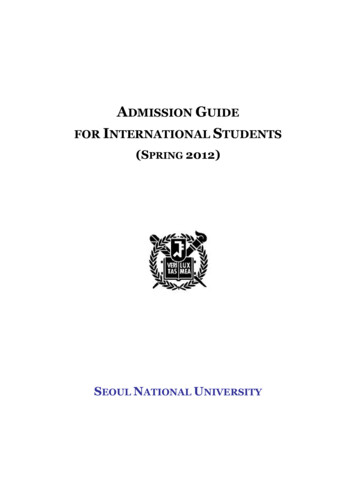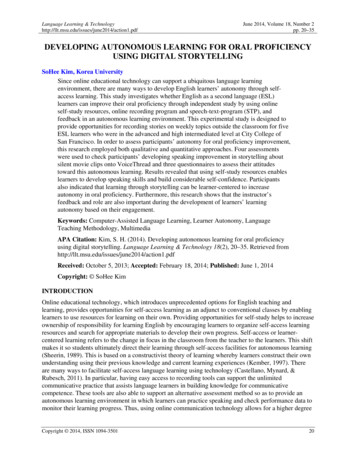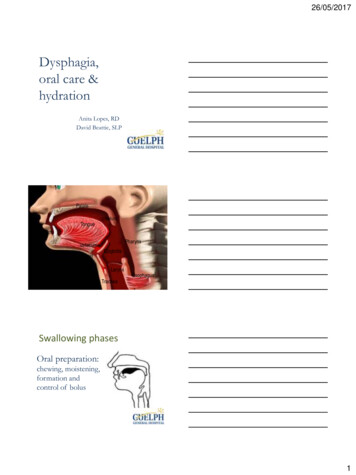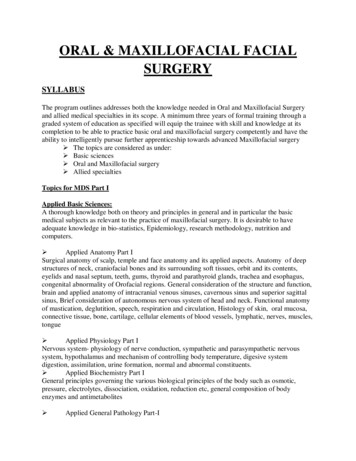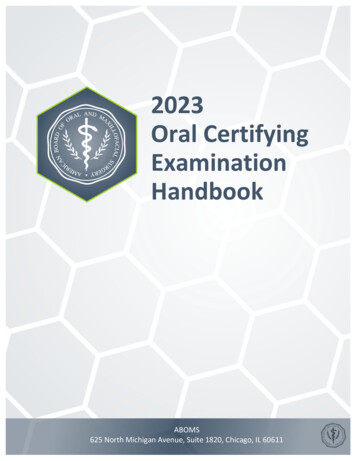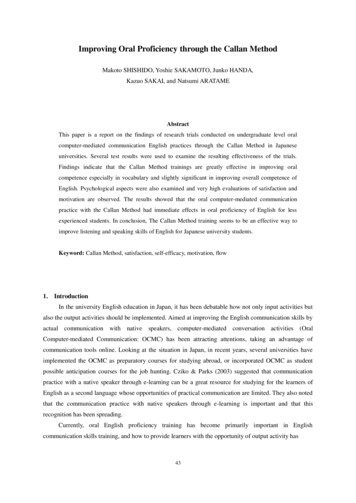
Transcription
Improving Oral Proficiency through the Callan MethodMakoto SHISHIDO, Yoshie SAKAMOTO, Junko HANDA,Kazuo SAKAI, and Natsumi ARATAMEAbstractThis paper is a report on the findings of research trials conducted on undergraduate level oralcomputer-mediated communication English practices through the Callan Method in Japaneseuniversities. Several test results were used to examine the resulting effectiveness of the trials.Findings indicate that the Callan Method trainings are greatly effective in improving oralcompetence especially in vocabulary and slightly significant in improving overall competence ofEnglish. Psychological aspects were also examined and very high evaluations of satisfaction andmotivation are observed. The results showed that the oral computer-mediated communicationpractice with the Callan Method had immediate effects in oral proficiency of English for lessexperienced students. In conclusion, The Callan Method training seems to be an effective way toimprove listening and speaking skills of English for Japanese university students.Keyword: Callan Method, satisfaction, self-efficacy, motivation, flow1. IntroductionIn the university English education in Japan, it has been debatable how not only input activities butalso the output activities should be implemented. Aimed at improving the English communication skills byactual communication with native speakers, computer-mediated conversation activities (OralComputer-mediated Communication: OCMC) has been attracting attentions, taking an advantage ofcommunication tools online. Looking at the situation in Japan, in recent years, several universities haveimplemented the OCMC as preparatory courses for studying abroad, or incorporated OCMC as studentpossible anticipation courses for the job hunting. Cziko & Parks (2003) suggested that communicationpractice with a native speaker through e-learning can be a great resource for studying for the learners ofEnglish as a second language whose opportunities of practical communication are limited. They also notedthat the communication practice with native speakers through e-learning is important and that thisrecognition has been spreading.Currently, oral English proficiency training has become primarily important in Englishcommunication skills training, and how to provide learners with the opportunity of output activity has43
NEXT GENERATION STUDIES No.1, November 2017become an important issue. Considering from the viewpoint of providing the framework of collegeeducation, it is expected for an output activity to be not only highly effective but also easy to introduce.The Callan Method is an English training method for learners of English as a second or foreignlanguage and it was developed by Robin Callan in UK in 1959. It is a kind of direct method and used bymillions of people across the world. It is believed to be an exceptionally quick way to successfully masterEnglish as a foreign language and designed specifically to improve listening and speaking abilities in alively and active environment. In particular it aims to extend the listening and speaking abilities.First of all, the dominant feature of Callan Method is speed. The utterance speed of instructor is veryfast; 220-240 words per minute (WPM), which is faster than those of native English speakers; 150-180WPM. Normally, English conversation school teachers are said to speak at a speed of 60-100 WPM andeven news reporters at 200 WPM. Secondly, the instructor should always ask each question twice at topspeed, and immediately start off the answer for the student by giving him or her the first two or threewords of the answer. The instructor should not wait a second for the student to answer, but shouldimmediately begin dragging the answer out of him/her by a pushing and pulling process. Thirdly, thereshould not be a moment’s silence in the lesson. The instructor and students should be speaking everysecond. Fourthly, it is extremely important for the instructor to correct the student's pronunciation. Finally,immediate feedback is always given to the student and, if abundantly given, students also increaseopportunities to obtain the “awareness” with respect to their own learning.The Callan lessons are mainly carried out in the flow of “instructor asks and student answers”structure. Starting from revision of the previous lesson, new vocabularies are introduced and the lessonmoves onto the reading and dictation. The content is also structured on a set up concept, starting from easyquestion and answer. QQ English was founded in 2009 and it organizes two language schools in Cebu,Philippines: one in IT Park and the other in Seafront. It teaches English to Japanese learners through Skype,adopting the Callan Method2. The StudyIn order to investigate possibilities for introducing OCMC into the Japanese university Englisheducation and to examine the effectiveness of OCMC, several trials were carried out for implementing oralpractices with the Callan Method through Skype and in class sponsored by the Institute for ServiceInnovation Studies of Meiji University, formerly known as the Institute for Civilization and Management.Nine trials have been conducted so far. (Table 1)44
Improving Oral Proficiency through the Callan MethodTable 1Research Trials for Implementing Oral Practice with Callan Method through Skype and in ClassYearMonthSchoolType# of Student# of Lesson12011September –DecemberMeiji Univ.On Line2150 min x 8022012July September320124Meiji Univ.10Jissen Women’s Univ.Kyoai Gakuen Maebashi Univ.On Line23890 min x 20November DecemberTokyo Music Univ.On Line690 min x 202012September DecemberMeiji Univ.On Line4890 min x 2052013May - JuneMeiji Univ.Jissen Women’s Univ.Face toFace9390 min x 2062013Kyorin Univ.On Line2050 min x 4072014May - JulyTakushoku Univ.On Line1090 min x 982014October DecemberTakushoku Univ.On Line1390 min x 2092014May - JulyShiraume JH &SHOn Line13 (JH7/SH6)25 min x 30November January3. FindingsSome of the results from the trials are to be introduced in order to prove that oral computer-mediatedcommunication English practices through the Callan Method are effective in Japanese universities.3.1 Research Findings from Trial #1The first trial was carried out between September and December in 2011. The participants werecollected at Meiji University and 21 students participated. The lessons were held on the on-line basisthrough Skype while the instructors work at the QQ English in Cebu, Philippines and the students attendedthe lessons at their homes in Japan. The students took 80 50-minute lessons during three months of the trial.The pre-test and post-test scores of TOEIC were compared in order to investigate the effect of the lessons.The lowest score in the pre-test was 275, the highest was 810, and the average was 586.9 points. Thelowest score in the post-test was 545, the highest was 850, and the average was 694.3 points. The smallestincrease of 30 points, the biggest of 250, and the average of 107.4 were observed. (Fig. 1)45
NEXT GENERATION STUDIES No.1, November 2017studentFigure 1. Pre-Test and Post-Test TOEIC Score Comparison of Trial #13.2 Research Findings from Trial #2The second trial was carried out during summer vacation between July and September, 2012. Thetotal of 41 students participated; 10 from Meiji University, 23 from Jissen University, and eight fromMaebashi Kyoai Gakuen College. The students received the total of 20 on-line based lessons throughSkype during three months of this trial. Each lesson was 90 minute long and consisted of 50 minutes of theCallan Method lesson and 25 minutes of TOEIC test preparation with 15 minutes of break in between. Inthe same way as the first trial, the instructors worked at QQ English in Cebu, Philippines and the studentsreceived the lessons at their homes in Japan through Skype. The pre-test and post-test scores of TOEIC,CASEC, and Versant tests were analyzed this time.CASEC is an abbreviation of Computerized Assessment System for English Communication and itmeasures English proficiency for listening and reading. The length of the exam is between 40 and 50minutes depending on test takers and the score range is 0 to 1,000 points. It has 61 questions in foursections in total; 16 questions in Vocabulary, 17 in Expression, 17 in Summary comprehension, and 11 inListening comprehension. Meanwhile, Versant is a speaking test through telephone and examines oralfluency of English. The score range is between 20 and 80 points. It has the total of 63 questions in sixsections; eight questions in Read aloud, 16 in Repeat, 24 in Question and answer, 10 in Comprehension,three in Summary and two in Free talk.First of all, Maebashi Kyoai Gakuen College conducted an analysis of its students with their TOEICraw scores. There were eight students from the College in this trial. The lowest score in pre-test was 255and the highest was 635. The lowest score in post-test was 300 and the highest was 700. The biggestincrease of 145 points and the average of 29 were reported. (Fig. 2)In order to analyze and compare the CASEC and Versant test scores, we developed the idea of ScoreDevelopment Rate (SDR) which indicates potential increase of scores of a test taker. We came up with thisidea because we felt that there was slight unfairness when we compared just the increases of raw scores.For example, if a student with 490 in pre-test gets 590 in post-test, the increase is 100 points. In the sameway, if a student with 890 in pre-test gets 990 in post-test, the increase is also 100. However, these46
Improving Oral Proficiency through the Callan Methodincreases may have different meanings. When we calculate these increases with SDR, there is a distinctivedifference between these two examples. The SDR of the former student is 20% while that of the latter is100%. The formula of SDR is as below.SDR (Post-Test Score – Pre-Test Score) / (Full Mark – Pre-Test Score)Example 1: TOEIC score increase 490 to 590(590-490) / (990-490) 20%Example 2: TOEIC score increase 890 to 990(990-890) / (990-890) 100%The difference is significant and so we decided to use the SDR to analyze the increases of test scores forthis trial.studentFigure 2. Pre-Test and Post Test TOEIC Score Increase of Maebashi Kyoai Gakuin CollegeStudentsSecondly, the SDR of CASEC was analyzed. The result showed an average of 6.7% increase in total.(Table 2) We can say that it is a slight increase. To make it clearer, here are some typical examples of scoreincrease of CASEC test takers; a student with the pre-test score of 400 increased to 440 in the post-test,and a student with 600 in the pre-test got 626 in the post-test, and one with 800 received 813.47
NEXT GENERATION STUDIES No.1, November 2017Table 2Score Development Rate of Pre-test and Post Test Scores of CASECSDR :CASECLowestGreat Increase 50%Big ence0200VocabularyExpression0Total 25% 50%68570Increase 10% 25%131091416Slight Increase 5% 10%06449Fluctuation -5% 5%866510Slight Decrease- -10% -5%62443Decrease -- -25% -10%56563Big Decrease --- -50% -25%11200 e3.2%5.5%-0.3%8.3%6.7%STD24.0%26.7%32.1%19.8%9.8% Great Decrease----Score Development RateThirdly, the SDR of Versant Test was studied and the average of 3.9% increase in total was observed.(Table 3) We categorize this increase as fluctuation. However, we noticed that there is an average of 20.1%increase in Vocabulary. We classify this as increase.48
Improving Oral Proficiency through the Callan MethodTable 3Score Development Rate of Pre-test and Post Test Scores of VersantSDR: VersantLowestGreat Increase 50%Big Increase 25%Increase SentenceVocabularyFluencyPronunciationTotal00000 50%42110 10% 25%1334779Slight Increase 5% 10%826713Fluctuation -5% 5%81181313Slight Decrease - -10% -5%31463Decrease -- -25% -10%30251Big Decrease --- -50% -25%00201 -50%10010Great Decrease----Score development 7.2%9.0%To summarize the Score Development Rates of the test results from pre-test and post-test of CASECand Versant, we observed a slight improvement of overall competence of English and great improvementof an oral competence of English especially in vocabulary.The psychological aspects were analyzed through pre and post lesson questionnaires throughout thethree months of trial. The first item in the questionnaires was about student satisfaction. We asked thestudents if they were satisfied after completing all the 20 lessons. 51% of the students responded verysatisfied, 46% satisfied, and only 3% answered ordinal. There were no students who said “not satisfied.”(Fig. 3)About the question on learning effectiveness or self-efficacy, 22% of the students replied veryeffective and 63% effective while 12% answered ordinal and 3% said little effective.(Fig. 4)49
NEXT GENERATION STUDIES No.1, November 20173%3%12%46%22%51%Very SatifiedVery EffectiveSatisfiedEffectiveOrdinalOrdinal63%Figure 3. Questionnaire-SatisfactionLittle EffectiveFigure 4. Questionnaire-Learning Effectiveness(Self-efficacy)As for the motivation, 56% of the students responded very motivative and 35% motivative. On theother hand, 3% of them said ordinal, 3% little motivative, and there were 3% of no response. (Fig. 5)3% 3%3%35%56%Very MotivativeMotivativeOrdinalLittle MotivativeNo ResponseFigure 5. Questionnaire-MotivationWhen motivation was analyzed, the following phrases were recognized as key words to indicate thatthe students were motivated: “I want to improve my speaking skills.” and “I want to speak more.”However, these phrases were considered as indications of contriving learning strategies: “I want to acquiremore vocabularies.” and “I need to read a conversation textbook.” The comments such as “I had someopportunities to learn English every day.” and “I used a English-English dictionary” were categorized asrevision of learning.As for cognitive learning strategies, 12% of the students responded that they tired a lot while 64%tried a few. 15% said ordinal, 3% replied few, and 6% answered none. In responding a question, what kindof ingenuities did you try?, there were many responses about preparation and reviewing and many studentssaid that they tried some in-class strategies.50
Improving Oral Proficiency through the Callan Method3%6%7%12%15%17%A lot17%A LotA FewA FewOrdinalOrdinalFewFew64%No59%Figure 6.Figure 7. Questionnaire-NoticesQuestionnaire-Contriving Learning StrategiesConsidering notices, 17% of the students responded that they noticed a lot and 59% a few. On theother hand, 17% replied ordinal and 7% said few. Some examples of indication of positive expressions are“I can do something.” There were 16 cases of such responses. For negative expressions, the phrases like “Irealized that I cannot do something” and “I have to do something” were recognized in the questionnairesand 14 cases of such comments were found. In either expression, high evaluations for satisfaction, learningeffectiveness, and motivation were observed. Therefore, we came to believe that self-efficacy and noticesfor improvement lead to positive learning attitudes.To summarize the questionnaires, very high evaluations for satisfaction, learning effectiveness(self-efficacy), and motivation were observed. In addition, high evaluations for contriving learningstrategies and notices were indicated. Consequently, we can conclude that only a few students contrivedlearning strategies (autonomic adjustment for learning) based on Notices and many students feltself-efficacy and gained high motivation.Concluding the findings from the second research trial, we discovered that the oralcomputer-mediated communication practice with the Callan Method was not very effective in over-allEnglish proficiency. However, immediate effect in oral proficiency for less experienced students can beexpected and immediate effect in some areas of proficiencies can also be expected especially in vocabulary.There are some expected changes of student attitude in learning. High evaluations for emotion wererecognized and positive attitudes of self-efficacy in learning were witnessed. Reduced resistance orhesitation for speaking in English was noticed and this will create the improvement of confidence.Maintaining and improving motivation will lead to continuity of learning3.3 Research Findings from Trial #5The fifth trial was conducted between May and June, 2013 and 93 students participated. Thestudents were collected from Meiji University and Jissen Women’s University. The total of 20 lessons wascarried out on face to face basis in classroom. Each lesson consisted of an instructor and three to fourstudents and lasted for 90 minutes. In this trial, researched items were self-evaluation of achievement inlistening and speaking, emotions during lessons, and flow state.51
NEXT GENERATION STUDIES No.1, November 2017Self-evaluation of achievement in listening and speaking was investigated by 20 Items forSelf-Evaluation of Listening and Speaking Skills based on Can-Do List by STEP . (Tables 4&5) Thestudents chose items for the “can do” before and after lessons. Self-evaluation of achievement responseswere numerically calculated.Table 4Items for Self-Evaluation of Achievement - ListeningItems for Self-Evaluation of Achievement - Listeninga. (Introduce foreign culture and life style)Understand simple contents of lecture and seminar in Englishb. (Announcement or Information of event)Understand important information of announcementc. (size, discount rate, stock availability)Understand simple explanations of clerk while shoppingd. (Speech and lecture)Understand very long conversation about topics of your own intereste. Understand important points of News programs on TV and radiof. (Directions for Train transfer, Explanation for delay)Understand directions and announcement in using airport and public transportationg. Understand order and inquiry on telephone if related to own work and specialized fieldh. (Speech in general education lecture)Understand various topics and issues in very long conversationi. (Planning an event, meeting at work)Understand opinions and comments in meetingsj. Understand News report on politics and economy on TV and radio52STEP LevelPointG21G21G21G Pre12G Pre12G Pre 12G Pre 12G13G13G13
Improving Oral Proficiency through the Callan MethodTable 5Items for Self-Evaluation of Achievement - SpeakingItems for Self-Evaluation of Achievement - SpeakingSTEP LevelPointG22G22G22G Pre 14G Pre 14G Pre 14G Pre 14h. Express opinions and ask questions about current social issues and topicsG16i . (Planning an event, meeting at work)Exchange opinions and comment in meetingsG16j (Changing schedule, negotiating price)Negotiate various topics through telephoneG16a. (reasons for being late or absent)Explain various situations happening in daily lifeb. (color, size, price)Explain what you are looking for, tell your preference and ask simplequestions to a shop clerk while shoppingc. (Tell Jason to call me back, Tell Jason that I cannot attend the meeting)Leave simple messagesd. (Presenting research results, giving a business presentation)Talk details about own research and surveye. Concerning your work and special field, Ask questions and give opinions about a lectureor presentationf. (Appointment for dentist, beauty salon)Deal with tasks and interactions in a set situationg. Explain summaries and outlines of books and moviesThe emotions during lessons were measured by SAN Emotion Scale (Sakai et al, 2013) (Figure 8).The meseasurements were conducted at the end of each lesson for 20 times with the scale and theresponses indicated what emotions students had during lessons.1–2–Figure 8. SAN Emotion Scale3–4–5–6-7In positive psychology, flow state, also known as the zone, is the mental state of operation in which aperson performing an activity is fully immersed in a feeling of energized focus, full involvement, andenjoyment in the process of the activity (Csíkszentmihályi, 1990). In order to investigate whether thestudents were in flow state or not, the student emotions were examined with the questionnaire at the end ofeach lesson for 20 times. (Table 6)53
NEXT GENERATION STUDIES No.1, November 2017Table 6Check List for Flow StateNumberQuestion1Challenging2Confident in doing well3Advancing forward toward goal4Doing well5Completely Concentrating6Working as you want7Forgetting about own self8Controlling (dealing) well9Forgetting about time10Having fun※「Confidence in abilities」(2,4,6,8), 「Positive emotion and Awareness experience byimmersion」(5,7,9,10), 「Challenge toward goal」(1,3) (Ishimura, 2008)The correlations were calculated between emotion, self-evaluation, and flow state in listening andspeaking (Table 7). A very strong correlation can be seen in the “emotion” category. Between “exitemotion” and “peak-end,” there is a very strong correlation with 0.954. According to the peak-end rule ofKahneman (Kahneman, 2011; Redelmeier & Kahneman, 1996), what is memorable can be determined bythe “peak-end” emotion (the average points of the peak emotion and end feelings). In this experiment, itmay be concluded that “peak-end” is determined by the “exit emotion.”A strong correlation can be found in the “flow state” category. Of the “flow state,” three items of“confidence in the ability,” “positive feelings and awareness by the immersive experience,” and “challengeto the target” have correlations of more than moderate each other, and particularly there is a strongcorrelation with 0.814 between “confidence in ability” and “challenge to the target.” In other words, aperson with high in “confidence in ability” has a strong tendency of higher in “challenge to the target.”This trend is more obvious among the people with low initial emotion with 0.887, the people with highinitial emotion show a correlation of 0.805.As for the “self-efficacy” classified by Can-Do list, between listening and speaking, and betweenbefore (pre) and after (post) the lessons, there are basically four combinations of the two times two.Judging from the fact that the strongest correlation with 0.749 is observed between “pre-listening” and“pre-speaking,” we can recognize that students who have confidence in speaking beforehand also have astrong confidence even in listening.54
Improving Oral Proficiency through the Callan MethodTable 7Correlation between Emotion, Self-Evaluation, and Flow State in Listening and SpeakingEmotionFlow State1EmotionSelf- eginningBeginningSelf-EvaluationFlow State1“Post-listening” and “post-speaking” has a moderate correlation of 0.603. This indicates that thestudents who gained confidence in listening afterwards also acquired moderate confidence in speakingafter training. These contributions are seen mainly among the people with high initial emotion, and thecorrelation coefficients are respectively 0.769 and 0.664.A strong correlation of 0.706 was recognized between “pre-speaking” and “post-speaking”, and it isobvious that the students who have confidence in speaking beforehand have strong confidence in speakingeven after the training. However, this trend is recognized primarily among the students with high initialemotions (5-7 out of 7 in the SAN emotion measurement scale) (r 0.713), it reduced to a moderatecorrelation of 0.513 among those with low initial emotions (1-4).An interesting fact among the students with low initial emotion is that the “post-speaking” and“Δspeaking” shows a strong correlation of 0.818. This is because, in case of students with low initialfeelings, speaking evaluation after training is determined mostly by the improvement of speaking.As for negative correlations, there are moderate negative correlations (r -0.571 and r -0.413,respectively) between the improvement in listening and pre-assessment listening and the improvement inlistening and pre-evaluation speaking. This means that the students with low confidence both in listeningand speaking beforehand show large improvement in listening in self-evaluation afterwards. Since there is55
NEXT GENERATION STUDIES No.1, November 2017no such relationship with the improvement in speaking in this course, it is understandable that self-efficacyhas indicated more improvement in listening than in speaking.Between “emotion” and “flow state” categories, because a moderate correlation of 0.451 is notifiedbetween the “peak emotion” and “challenge to the target,” the students with strong “peak emotion” seem tobe aggressive in “challenge to the target.” This is mainly because there is a contribution from the studentsfrom low initial emotion (r 0.501).In the “self-efficacy” and “emotion” categories, only weak correlations were observed. However,when limited to the students with low initial emotion, there are moderate correlations between the “initialemotion” and “peak emotion” in speaking and “end emotion” and “peak-end” in listening. That is the“initial feelings” is correlated moderately both with the “pre-speaking” (r 0.543) and with “post-speaking”(r 0.449). On the other hand, “end emotion” and “pre-listening” have a moderate correlation of 0.420 anda medium correlation of 0.612 can be seen between “end emotion” and “post-listening.” In this way, low“initial emotion” reflects in the low “self-efficacy” in speaking and “self-efficacy” in listening is reflectedin the “end emotion.”There are some typical features about the relationships between the “self-efficacy” and othercategories. In other words, “confidence in the ability” has a moderate correlation of 0.513 with“pre-speaking” and “challenge to the target” is moderately correlated with “peak emotion” (r 0.501).However, only weak correlations are observed between these categories among the students with highemotion. In case of the students with low initial emotion, the lack of “self-confidence” in speaking beforetaking the course is reflected in the low level of “confidence in the ability” and the high level of the “peakemotion” enhances high score in the “challenge to the target.”Here are a summary of observed results from correlations.・ High scores in emotion at beginning greatly affect continuity rate of learning.・ Emotions to lessons were determined by emotional state at the end.・ High scores in confidence in skills co-relate with high scores in challenge toward goal.・ Students with strong peak emotions indicated active result in challenge toward goal.・ Students with confidence in speaking at the beginning have strong confidence in listening.・ Students with confidence in listening have moderate confidence in speaking at the end.・ Students with confidence in speaking at the beginning also have strong confidence in speaking at theend.・ Students with little confidence in listening and speaking at the beginning showed large improvement oflistening and speaking in self-evaluation.・ Self-evaluation in listening showed more improvement than speaking.・ Post lesson evaluations for speaking were determined by the improvement at the end of lesson.・Low emotions affect low self-evaluation for speaking and also influence the end emotions ofself-evaluation.・ Little confidence in speaking at the beginning affect low confidence in skill and high in peak emotionfacilitates challenge toward goal.56
Improving Oral Proficiency through the Callan MethodIn this trial, through the face-to-face in class conversation practice in small groups, we tried toobserve how the students engage in their introspection in terms of self-efficacy and emotional aspects.Despite the trial was carried out in a short period of 20 times, the increase in the self-efficacy was observedafter the course as a whole. However, as for the changes in self-efficacy, more accurate self-analysisthrough the course is suggested and so the interpretation requires a more careful verification.In the emotional aspects, it became obvious that growing emotion at the beginning of the course canbe a major impact on the maintenance of the subsequent course continuous rate. In addition, the heightenedemotion at the beginning was also likely to be maintained until the end of the course. Regardless of thelevel of emotion at the beginning, we found that the students with high in “confidence in the ability” arealso higher in “challenge to the target.” And especially in the group of students with low initial emotion,the students with strong “peak emotion” tend to be positive in the “challenge to the target.”As for the relationship between the emotional aspect and self-efficacy, I noticed the followingfeatures. Overall, those who have the confidence in speaking beforehand have a strong self-confidenceeven in listening. In addition, those who are not confident in listening and speaking before the trial showedhigher improvement of self-efficacy in listening. Since there is no such relationship with the improvementin speaking, in this trial, it is evident that the students can improve self-efficacy more in listening thanspeaking.Looking at each group by the levels of emotion at the beginning, in a group of the students with highemotion at the beginning, the stu
The Callan Method is an English training method for learners of English as a second or foreign language and it was developed by Robin Callan in UK in 1959. It is a kind of direct method and used by millions of people across the world. It is believed to be an exceptionally quick way to successfully master




